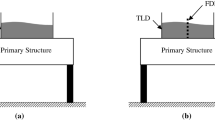Abstract
Energy dissipation devices are increasingly used as vibration mitigation systems owing to their efficiency. Therefore, many attempts were made to facilitate their design process. The design of fluid viscous dampers is summarized in the selection of suitable damping values and their location in the structure. This paper presents a strategy that estimates the damping coefficient value for nonlinear fluid viscous dampers in a straightforward manner. This minimizes the design time, and thus, more flexibility is offered for further design considerations. Combining a methodology that predicts a linear damping coefficient based on the concept of target-damping ratio, then, applying an equivalent energy-consumption approach to determine the nonlinear damping coefficient. This research gives a description of the method and its implementation by studying a structure equipped with a set of additional fluid viscous dampers. The results illustrate the efficiency and simplicity of the method.







Similar content being viewed by others
References
Adachi F, Yoshitomi S, Tsuji M, Takewaki I (2013) Nonlinear optimal oil damper design in seismically controlled multi-story building frame. Soil Dyn Earthq Eng 44(1):1–13
Attard TL (2007) Controlling all interstory displacements in highly nonlinear steel buildings using optimal viscous damping. J Struct Eng 133(9):1331–1340
Belgasmia M (2019) Optimization of design for better structural capacity. IGI Global. https://doi.org/10.4018/978-1-5225-7059-2
Constantinou MC, Symans MD (1992) Experimental and analytical investigation of seismic response of structures with supplemental fluid viscous dampers. National Center for earthquake engineering research, Buffalo, NY
De Domenico D, Ricciardi G (2018) Improved stochastic linearization technique for structures with nonlinear viscous dampers. Soil Dyn Earthq Eng 113:415–419
De Domenico D, Ricciardi G, Takewaki I (2019) Design strategies of viscous dampers for seismic protection of building structures: a review. Soil Dyn Earthq Eng 118:144–165
Denoël V, Degée H (2009) Asymptotic expansion of slightly coupled modal dynamic transfer functions. J Sound Vib 328(1–2):1–8. https://doi.org/10.1016/j.jsv.2009.08.014
Duflot P, Taylor D (2008) Experience and practical considerations in the design of viscous dampers. In: Footbridge third international conference
Duflot P, Viganò GM, Denoël V (2017) Method for preliminary design of a system of viscous dampers applied to a tall building. In: 7th European and African conference on wind engineering (EACWE 2017). International Association for Wind Engineering (IAWE).
Gherb, A, Belgasmia M (2019) Wind loads on structures, and energy dissipation systemes optimization. In: Optimization of design for better structural capacity. IGI Global, pp 128–149. https://doi.org/10.4018/978-1-5225-7059-2
Haskell G, Lee D (1996) Fluid viscous damping as an alternative to base isolation. In: Pressure vessels and piping conference, Montreal (Canada). American Society of Mechanical Engineers, p 141
Hwang JS, Huang YN, Yi SL, Ho SY (2008) Design formulations for supplemental viscous dampers to building structures. J Struct Eng 134(1):22–31
Kahan M (2000) Dimensionnement simplifié d’amortisseurs visqueux non linéaires pour ponts en zone sismique. Revue française de Génie civil 4(1):35–55
Kandemir-Mazanoglu EC, Mazanoglu K (2017) An optimization study for viscous dampers between adjacent buildings. Mech Syst Signal Process 89:88–96. https://doi.org/10.1016/S0888-327(01)630163-7
Lin WH, Chopra AK (2002) Earthquake response of elastic SDF systems with non-linear fluid viscous dampers. Earthq Eng Struct Dyn 31(9):1623–1642
Martinez-Rodrigo M, Romero ML (2003) An optimum retrofit strategy for moment resisting frames with nonlinear viscous dampers for seismic applications. Eng Struct 25(7):913–925. https://doi.org/10.1016/S0141-0296(03)00025-7
Moreschi LM (2000) Seismic design of energy dissipation systems for optimal structural performance, Ph.D. thesis, University of Virginia Tech
Paola MD, Mendola LL, Navarra G (2007) Stochastic seismic analysis of structures with nonlinear viscous dampers. J Struct Eng 133(10):1475–1478. https://doi.org/10.1061/0733-9445(07)133-10
Parcianello E, Chisari C, Amadio C (2017) Optimal design of nonlinear viscous dampers for frame structures. Soil Dyn Earthq Eng 100:257–260
Pekcan G, Mander JB, Chen SS (1999) Fundamental considerations for the design of non-linear viscous dampers. Earthq Eng Struct Dyn 28(11):1405–1425
Pollini N, Lavan O, Amir O (2017) Minimum-cost optimization of nonlinear fluid viscous dampers and their supporting members for seismic retrofitting. Earthq Eng Struct Dyn 46(12):1941–1961. https://doi.org/10.1002/eqe.2888
Şigaher AN, Constantinou MC (2003) Scissor-jack-damper energy dissipation system. Earthq Spectra 19(1):133–158
Silvestri S, Gasparini G, Trombetti T (2010) A five-step procedure for the dimensioning of viscous dampers to be inserted in building structures. J Earthq Eng 14(3):417–447
Soong TT, Constantinou MC (eds) (2014) Passive and active structural vibration control in civil engineering. Springer, Wien . https://doi.org/10.1007/978-3-7091-3012-4
Soong TT, Spencer BF Jr (2002) Supplemental energy dissipation: state-of-the-art and state-of-the-practice. Eng Struct 24(3):243–259. https://doi.org/10.1016/S0141-0296(01)00092-X
Strømmen EN (2014) Structural dynamics. Springer, Cham. https://doi.org/10.1007/978-3-319-01802-7
Symans MD, Constantinou MC (1999) Semi-active control systems for seismic protection of structures: a state-of-the-art review. Eng Struct 21(6):469–487. https://doi.org/10.1016/S0141-0296(97)00225-3
Symans MD, Charney FA, Whittaker AS, Constantinou MC, Kircher CA, Johnson MW, McNamara RJ (2008) Energy dissipation systems for seismic applications: current practice and recent developments. J Struct Eng 134(1):3–21. https://doi.org/10.1061/0733-9445(2008)134:1-3
Tabar AM (2019) Linearization of seismic response of structures equipped with nonlinear viscous dampers using perturbation technique. Eng Struct 184:459–468
Takewaki I (2009) Building control with passive dampers: optimal performance-based design for earthquakes. Wiley, Singapore
Author information
Authors and Affiliations
Corresponding author
Ethics declarations
Conflict of interest
None.
Rights and permissions
About this article
Cite this article
Gherbi, A., Belgasmia, M. A Simplified Design Strategy of Nonlinear Fluid Viscous Dampers for MDOF Structures. Iran J Sci Technol Trans Civ Eng 46, 857–864 (2022). https://doi.org/10.1007/s40996-021-00635-6
Received:
Accepted:
Published:
Issue Date:
DOI: https://doi.org/10.1007/s40996-021-00635-6




